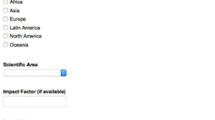Abstract
In this study, the possibilities to extend the basis for research performance exercises with editorial material are explored. While this document type has been traditionally not considered as an important type of scientific communication in research performance assessment procedures, there is a perception from researchers that editorial materials should be considered as relevant document types as important sources for the dissemination of scientific knowledge. In a number of these cases, some of the mentioned editorial materials are actually ‘highly cited’. This lead to a thorough scrutiny of editorials or editorial material over the period 1992–2001, for all citation indexes of Thomson Scientific. The relevance of editorial materials through three quantitative bibliometric characteristics of scientific publications, namely page length, number of references, and the number of received citations, are thoroughly analyzed.








Similar content being viewed by others
References
Campanario, J. M., Carretero, J., Marangon, V., Molina, A., & Ros, G. (2011). Effect on the journal impact factor of the number and document type of citing records: a wide-scale study. Scientometrics, 87, 75–84.
Costas, R., van Leeuwen, T.N., & Bordons, M. (2012). Referencing patterns of individual researchers: do top scientists rely on more extensive information sources? Journal of the American Society for Information Science and Technology, (in press).
Frandsen, T. F. (2008). On the ratio of citable versus non-citable items in economics journals. Scientometrics, 74, 439–451.
Garfield, E. (1987). Why are the impacts of the leading medical journals so similar ad yet so different? Item-by-item audits reveal a diversity of editorial material. Current Contents, 2, 7–13.
Harzing, A.W. (2010). Working with ISI data: Beware of categorisation problems. http://www.harzing.com/ISI_categories.htm. Accessed 13 Feb 2012.
Harzing, A.W. (2013). Document categories in the ISI Web of Knowledge: Misunderstanding the social sciences? Scientometrics. doi:10.1007/s11192-012-0738-1.
Lewison, G. (2009). The percentage of reviews in research output: a simple measure of research esteem. Research Evaluation, 18, 25–37.
Rousseau, R. (2009). The most influential editorials. In: Celebrating scholarly communication studies. A festschrift for Olle Persson at his 60th birthday, (pp. 47–53).
Sigogneau, A. (2000). An analysis of document types published in journals related to physics: Proceeding papers recorded in the Science Citation Index database. Scientometrics, 47, 589–604.
Van Leeuwen, T. N. (2007). Modelling of bibliometric approaches and importance of output verification in research performance assessment. Research Evaluation, 16, 93–105.
Van Leeuwen, T. N., Moed, H. F., & Reedijk, J. (1999). Critical comments on Institute for Scientific Information impact factors: a sample of inorganic molecular chemistry journals. Journal of Information Science, 25(6), 489–498.
Van Leeuwen, T. N., van der Wurff, L. J., & de Craen, A. J. M. (2007). Classification of ‘research letters’ in general medical journals and its consequences in bibliometric research evaluation processes. Research Evaluation, 16(1), 59–63.
Waltman, L., van Eck, N. J., van Leeuwen, T. N., Visser, M. S., & van Raan, A. F. J. (2011). Towards a new crown indicator: some theoretical considerations. Journal of Informetrics, 5(1), 37–47.
Zuccala, A., & van Leeuwen, T. N. (2011). Book reviews in humanities research evaluations. Journal of the American Society of Information Science and Technology, 62, 1979–1991.
Acknowledgments
The authors want to thank their colleague Gunnar Sivertsen (NIFU, Norway) for his valuable comments and discussion during the progress of our research.
Author information
Authors and Affiliations
Corresponding author
Rights and permissions
About this article
Cite this article
van Leeuwen, T., Costas, R., Calero-Medina, C. et al. The role of editorial material in bibliometric research performance assessments. Scientometrics 95, 817–828 (2013). https://doi.org/10.1007/s11192-012-0904-5
Received:
Published:
Issue Date:
DOI: https://doi.org/10.1007/s11192-012-0904-5




